AURORA ALERTS: Did you miss the Northern Lights? Next time get a wake-up call from Space Weather PHONE | | |
SPACE PLANE BUZZES ANDROMEDA: Last night in Flagstaff, Arizona, David Blanchard watched the US Air Force's X-37B space plane soar across the sky--and right past the Andromeda galaxy. "The X-37B was not as bright as the International Space Station (ISS), which also made an appearance, but our clear skies made it easy to see." Blanchard's images of the ISS, X-37B, and Andromeda may be found here. The X-37B will overfly many more US towns and cities in the nights ahead. You can find it using your cell phone.
SPACE STATION RADAR ECHO: The US Air Force Space Surveillance Radar in Kickapoo, Texas, is constantly scanning the heavens for objects orbiting or passing by Earth. This week it caught a whopper. At 21:13 CDT on Sept. 13th, the International Space Station passed through the radar beam, producing a powerful echo. Click on the image to listen:

The sound you just heard came from the loudspeaker of a receiver in Roswell, New Mexico, where radio engineer Stan Nelson recorded event. "The ISS was passing over Lubbock, Texas--midway between me and the Air Force radar," says Nelson. "It was the perfect geometry for catching the echo."
As the ISS raced through the radar beam, its velocity vector rotated with respect to the transmitter below. That's why the echo sounds like the frequency-shifting whistle of a passing train. It's the Doppler effect, working in space the same way it does on Earth.
The space station will be making more passes through the radar beam in the days ahead: Sep. 15 @ 20:31:37 CDT; Sep. 17 @ 11:48:29 CDT; Sep. 19 @ 11:06:38 CDT. Tune in to SpaceWeather Radio for live echoes.
EQUINOX AURORAS: Last night, the sun's magnetic field near Earth tipped south. This opened a crack in Earth's magnetosphere. Solar wind poured in and fueled a magnificent display of arctic Northern Lights:

Thilo Bubek took the picture not far from Tromsø, Norway. "We had some nice auroras," he says, with what can only be described as Norwegian understatement. "The clouds and calm sea contributed to a photogenic scene."
This is the time of year when south-pointing magnetic fields from the sun frequently puncture our bubble of protection against the solar wind. High latitude sky watchers should be alert for equinox auroras.
Sept. 2010 Northern Lights Gallery
[previous Septembers: 2009, 2008, 2007, 2006, 2005, 2004, 2002, 2001, 2000]
Potentially Hazardous Asteroids (
PHAs) are space rocks larger than approximately 100m that can come closer to Earth than 0.05 AU. None of the known PHAs is on a collision course with our planet, although astronomers are finding
new ones all the time.
On September 15, 2010 there were 1144 potentially hazardous asteroids.
Notes: LD means "Lunar Distance." 1 LD = 384,401 km, the distance between Earth and the Moon. 1 LD also equals 0.00256 AU. MAG is the visual magnitude of the asteroid on the date of closest approach. | | The official U.S. government space weather bureau |
| | The first place to look for information about sundogs, pillars, rainbows and related phenomena. |
| | Researchers call it a "Hubble for the sun." SDO is the most advanced solar observatory ever. |
| | 3D views of the sun from NASA's Solar and Terrestrial Relations Observatory |
| | Realtime and archival images of the Sun from SOHO. |
| | from the NOAA Space Environment Center |
| | from the National Solar Data Analysis Center |

